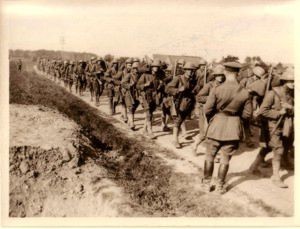Stories from the veterans:
William Ellsworth Kepner
Howard County, Indiana
Distinguished Service Cross:
"While in command of a battalion, Captain Kepner personally led one company of his command in an attack on a woods occupied by a company of German machine gunners. He was the first man to enter the woods, and later when part of the attacking company was held up by flanking machine-gun fire, he, with a patrol of three men, encircled this machine gun, and after a hard hand-to-hand fight, put the gun out of action." (Ed note: Lt Kepner transferred to the Army Air Corps after the war and became an airship pilot. He was promoted to Major General in WW2 and commanded the 8th Air Force, 2nd Bomb Division completing 24 combat missions.)
Ripley County
“Had orders to ‘go over the top’ on the morning of November 11, 1918, to take the city of Adenaard, Belgium which was held by the Germans. The order was held up on November 10 and the troops halted until the evening of November 11, when they moved into Adenaard and stayed until November 18th.
“On November 11, the refugees began coming through the lines in the forenoon. They were extremely destitute, being very inefficiently clothed. Most of them found their homes destroyed. They had no funds, so a bread and soup kitchen was opened for them in the Hotel de Ville. For shelter, these refugees were quartered in cellars and other parts of large, empty buildings such as stores and warehouses.
“The soldiers cleaned up the city while occupying it; hauled refuse such as brick and plaster from the streets. Moved church property from a place of storage in the convent, back to the churches not destroyed. All bridges across the Scheldt were mined and these mines are thrown as soon as the Americans entered the city and had to be rebuilt.
Florence Leo Fischer, Co. F, 334th Inf., 84th Div.,
Ripley County, Indiana
Spent 21 days under fire in the trenches at Verdun.
Walter Morrison, Infantry, AEF,
Ripley County, Indiana
“Hiked to Germany November 11 – December 3, 1918, via Luxembourg into Coblenz Area, at Cochon from Dec. to April 10, 1919. Moved up to the Rhine until July 1, 1919. Returned by train through Belgium to Brest, France.
“The 4th Division was known as the ‘Lost Division’ due to lack of newspaper exploitation. This lack is explained by the fact that this was a miscellaneous division, belonging to no particular section of the United States in the organization.
“The insignia is four ivy leaves in a circle, its meaning ‘The ivy clings to its friends, is poison to its enemies.”
(See patch below)
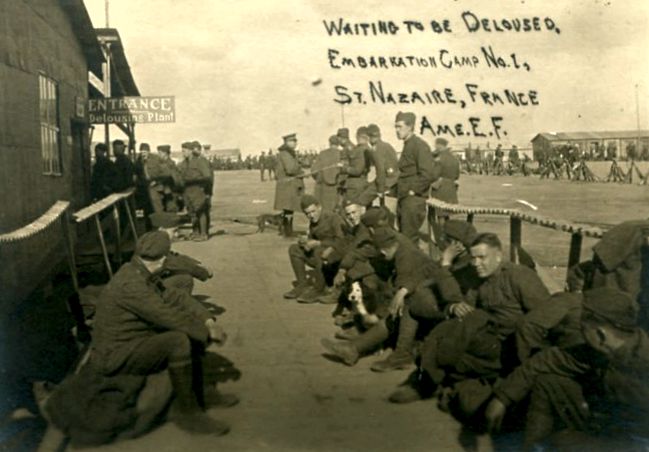
Waiting to be deloused
Embarkation Camp #1, St. Nazaire, France, Ame. E. F.
French real-photo postcard of U.S. Army soldiers standing outside of the entrance to the Delousing Plant at the U.S. Army Embarkation Camp No. 1 at the port of Saint-Nazaire, France, waiting to be deloused before shipping out to the United States (Undated)
From Thomas C. Alston Papers, WWI 66, WWI Papers, Military Collection, State Archives of North Carolina, Raleigh, N.C.
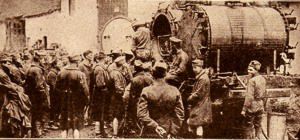
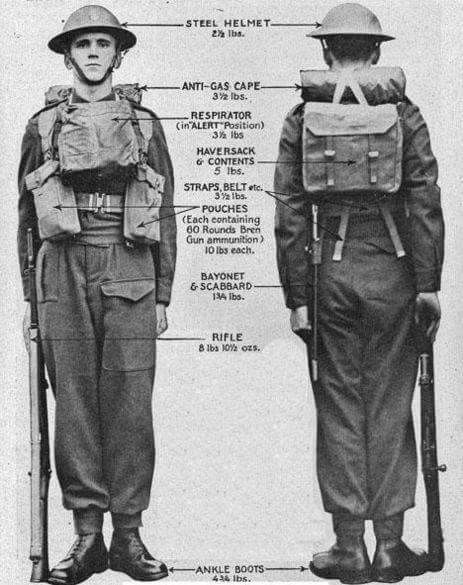
Full Infantry Uniform
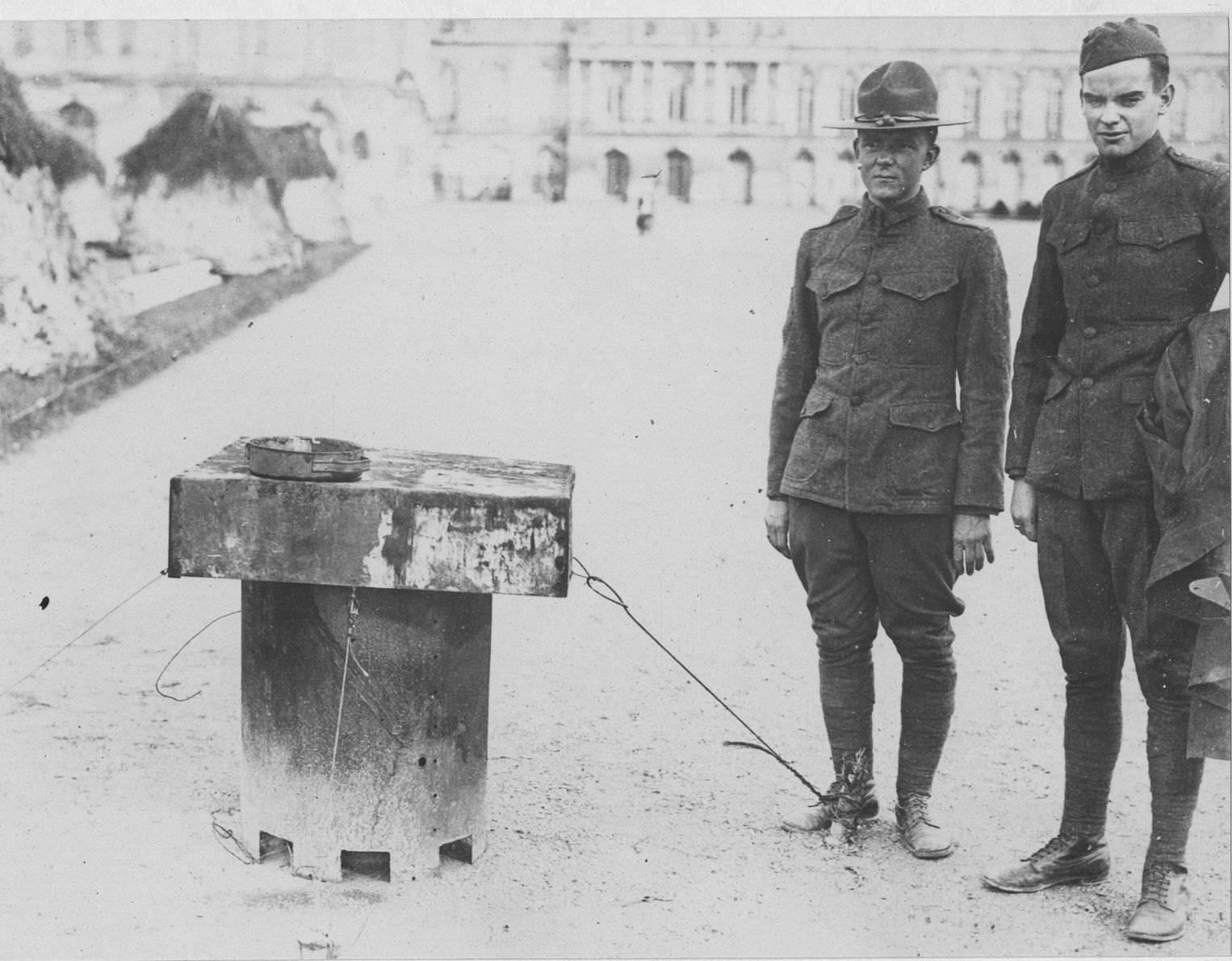
"NEW DEVICE FOR CREATING SMOKE SCREENS
A number of these stove like devices have been placed in different sections of Paris, France. The device can create a heavy smoke screen which completely mantels the surrounding territory so that certain places cannot possibly be distinguished. The volume of smoke is so dense that a searchlight cannot penetrate it."
National Archives Photo
General Pershing
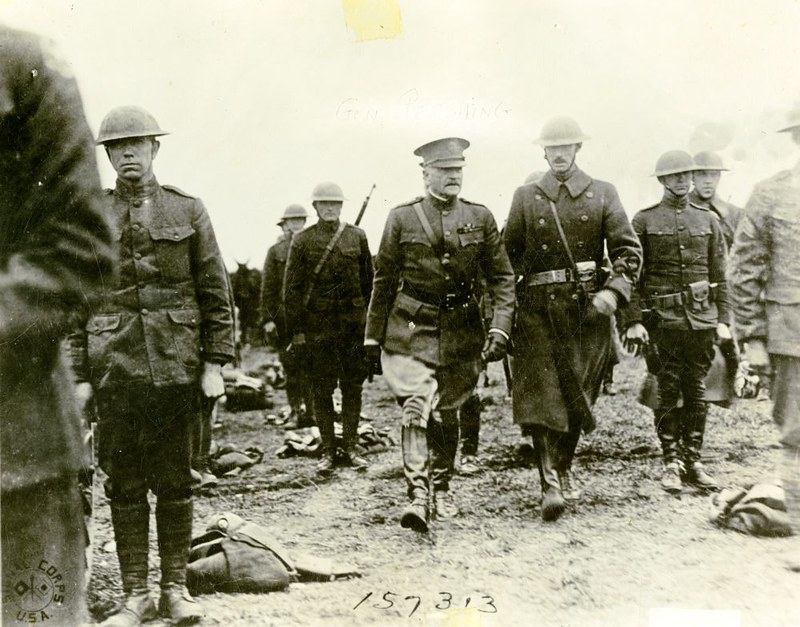
General Pershing. From the Captain Albert T. Willis Collection, 1917-1919, PhC.21; World War I scenes in England and France associated with the 322nd Infantry and 81st Division, 1917-1919.
US Army Signal Corps photo
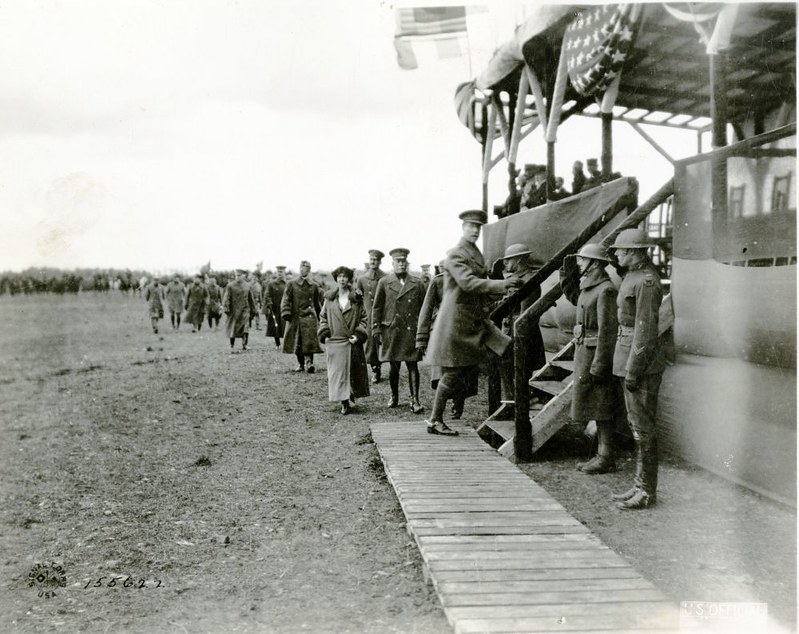
81st Division Review. General Pershing. Note: "Wildcat" Division shoulder patch on officer to the far right. From the Captain Albert T. Willis Collection, 1917-1919, PhC.21; World War I scenes in England and France associated with the 322nd Infantry and 81st Division, 1917-1919.
US Signal Corps photo
COOTIES
Body lice were an affliction that many men in the trenches had to deal with. "Our little brothers in the trenches" were called greybacks in the civil war. As soldiers moved closer to the front, long periods in the trenches without basic sanitation enabled the pests to flourish. Delousing plants were established and offered quick relief to the soldier and his clothing.
The "Cootie Machine" deloused the soldier's uniforms with fumigation to help rid them of the pests.
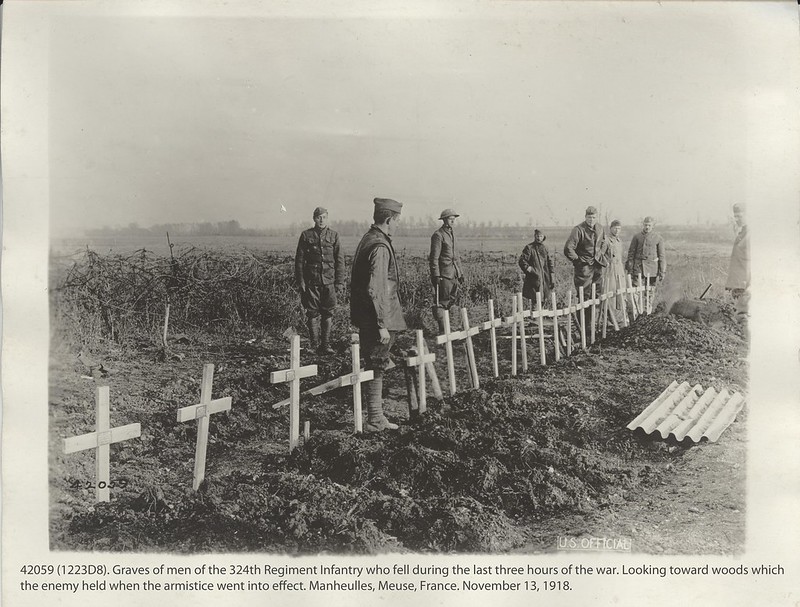
View of the graves of men of the 324th Infantry Regiment, 81st Division, who fell during the last three hours of the war at Manheulles, France. View is looking toward the woods which the enemy held when the Armistice went into effect. Photograph taken on November 13, 1918.
US Signal Corps photo
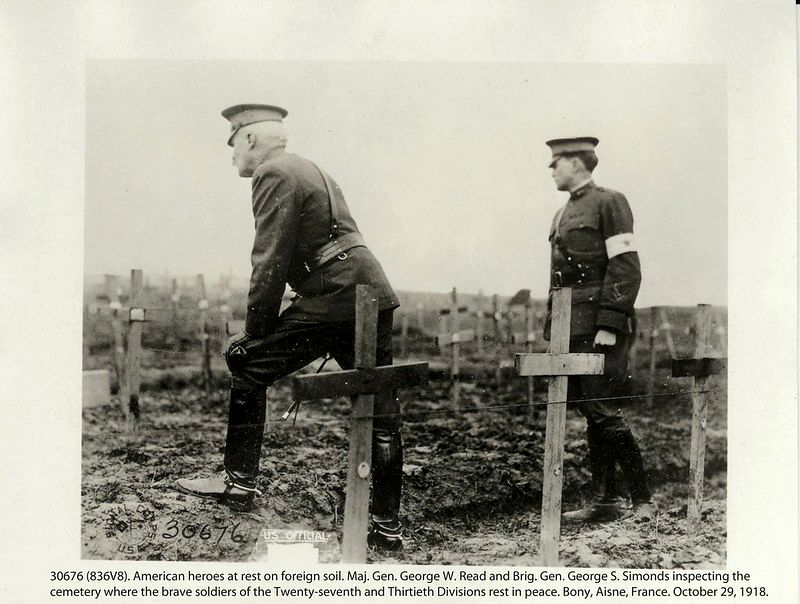
View of Maj. Gen. George W. Read (left) and Brig. Gen. George S. Simonds (right) inspecting the cemetery at Bony, France, on October 29, 1918, where American soldiers of the 27th and 30th Divisions, 2nd Army Corps, were buried.
US Army Signal Corps photo
Owen Eugene Newlon
Lake County, Indiana
Silver Star:
"Sergeant Newlon, learning the battery had been ordered into position near Mouzay, took his rolling kitchen, water cart and ration cart into Mouzay with the first line of the Infantry, over a road exposed to machine-gun and shell fire. Sergeant Newlon, being unable to get communication with the battery and knowing that the men were in dire straits for rations, kept his outfit in this town until he learned the location of the battery position, in spite of a warning from the Infantry commander that it was very dangerous, and succeeded in getting food to the firing battery."
Fred Beverly Vawter, Infantry, Italian Medal of Valor, Clark County, Indiana
Awarded for exploit at Tagliamento River 11/3/1918. “Also spent some time in the Commons, Austria & Cattaro Dalmatia and Mandres, France, a quaint rural village in the High Department of the Marne near Chaumont.”
Raymond O. Miller, Capt., 56th Infantry, 28th Div., Wells County, Indiana
He is a distinguished rifle & pistol marksman, winning the national championship: Infantry rifle team, 1920; pistol team, 1925; captain, pistol team, 1927,1928; coach, rifle team 1928. Gassed: Vosges Battles: St. Mihiel, Meuse-Argonne. Silver Star, Citation Certificate-Gallantry in Action
![INFGroup photograph of the 120th Infantry, [30th Infantry Division], commanded by Col. William B. Cochran, at Camp Sevier, S.C., on March 16, 1918. INFGroup photograph of the 120th Infantry, [30th Infantry Division], commanded by Col. William B. Cochran, at Camp Sevier, S.C., on March 16, 1918.](https://wwvets.org/wp-content/uploads/2020/08/INFGroup-photograph-of-the-120th-Infantry-30th-Infantry-Division-commanded-by-Col.-William-B.-Cochran-at-Camp-Sevier-S.C.-on-March-16-1918..jpg)
Group photograph of the 120th Infantry, [30th Infantry Division], commanded by Col. William B. Cochran, at Camp Sevier, S.C., on March 16, 1918.
US Army Signal Corps photo

View of Company C, 322nd Infantry, 81st Division, American Expeditionary Forces, in France in May 1919.
US Army Signal Corps photo
4th Division
The 4 Ivy leaves symbolized the Roman Numeral 4 (IV) and signified their motto of "Steadfast and Loyal" They fought at St. Mihiel, two Meuse-Argonne offensives and served in the Army of Occupation.
Wikipedia
→
28th Keystone Division
It was called "the bloody bucket" by the German forces due to the insignia.
It was composed of National Guardsmen from Pennsylvania, Maryland, Ohio, and New Jersey and can trace lineage back to Benjamin Franklin's battalion.
https://en.wikipedia.org/wiki/28th_Infantry_Division_(United_States)
↓
34th Infantry Patch
First American division sent to Europe where they fought in the Italian Campaign.
Indiana War Memorial Archives
←
89th Division Shoulder Patch (Kansas National Guard)
Called the "middle western Division it was assembled from infantrymen from Missouri, Kansas, Arizona, Colorado, Nebraska, New Mexico, and Nevada. They fought in the Battles of Saint-Mihiel and Meuse-Argonne.
The standard patch of the 89th is a white W on a blue background encircled with red.
Indiana War Memorial Collection
→
32nd Division Shoulder Patch
Red Arrow Division
The first Allied division to pierce the Hindenburg Line. The patch reflects a red arrow to signify this accomplishment.
Indiana War Memorial Archives
↓
30th Infantry Division
Named "Old Hickory" in honor of Andrew Jackson. They were assigned to the British Expeditionary Force using British equipment they fought at Ypres-Lys, Somme. St. Quenton Canal and the Hindenberg Line.
Wikipedia
←
Testimonials
What the Veterans said:
Leora McKinley Weare, Infantry, 30th Div., KIA St. Quintin, Ripley County, Indiana
“Hiked to Belgium from Eperlocques, July 4, 1918. Reached Watteau, Belgium on July 4. Went to Lyons and relieved the British soldiers in the trenches between Ypres and Kimmel Hill. Held the trenches for 17 days, going in on July 15 and coming out on August 2, 1918. Rested at Watteau, 4 days. Returned to the trenches for 20 days more. On August 3rd, captured Voormezeele with several prisoners and guns.
Left Belgium on September 5, 1918. Went in boxcars to Roelle-court, France. Was attached to the Second British Army and trained until September 17th. Moved South to Trencourt, Sept., 22, and took over first-line trenches from the Australians on Sept 23rd and 24th. Held this position until September 29th.
On September 29th, 1918 the 30th American Division, 27th American Division, and 46th British Division on the right, the 30th in the center, assaulted the Hindenburg Line which at the point of the assault curved in front of St. Quintin and was considered by the Germans to be unbreakable. The 60th Brigade, the 119th and the 120th Infantry, supported the 117th and 118th Infantries, American troops, 30th Division, attacked at 5:50 AM and captured with the tunnel system, the German troops holding the city of Bellecourt with five adjacent smaller towns and two entire German Divisions were defeated. 147 officers and 1,434 soldiers were taken, prisoners.
Co. M went into the fight with 218 men, came out with 49. Fifty-two were killed, 17 wounded. Ora Weare was killed by a high explosive shell. He was hit in the back and suffered a double fracture of the leg.
The dead were buried on October 2, about 200 yards of the wall of St. Quintin, 3 Ripley County boys, side by side as they fell.
Charles Allan Schofner, Sergeant, Vanderburg County, Indiana
- Co. K, 335th Infantry, 84th Div.
- Co. K, 28th Infantry, 1st Div.
- Co. B, 3rd Army Composite Regiment
While with Co. B., 3rd Army Composite Regiment, Paraded in Paris July 4 and 14th and on several occasions at the Pershing Stadium, Paris France. Also paraded in London, England this parade July 19; New York, September 10 and in Washington, September 17, 1919.
Russell Manship, Co. M, 126th Infantry, 34th Div., Goldstar, Hamilton County
Died Oct. 18, 1918, from wounds received in action while fighting in the Argonne Sector.
Clyde Charles Peters, Infantry, AEF, Ripley County, Indiana
“34th & 64th Infantry were the 14th Brigade and were trained in France until October 1, 1918, when pronounced ready for action and sent to the Puvenelle Sector. Here they were under fire from German snipers and machine guns, artillery barrages, and also airplane bombardment. The order to advance came on November 9th. The regiment was formed to advance in three waves. The first wave advanced to the objective assigned them, the second wave advanced through this line to the next objective and the third wave on through the third objective. Thus it was a continual drive until November 11 when the Armistice stopped the advance. Only 84 men were left of the 250 of the month before in Company K. 34th Infantry.”
James Bethel Gresham, Company F, 16th Infantry, Vanderburg County
First American casualty of World War I.
"Prof. John B. McMaster in his work, 'United States in the World War," gives the following account of the battle:
"The first trench fighting occurred just before dawn on the morning of November 3, with a small detachment of Americans in a front line instruction salient were attacked by a superior force of Germans and the salient cut off from the rest of the men by a heavy barrage. The fighting then became hand-to-hand. In the course of it, three Americans were killed, five wounded and 11 taken prisoners. The dead were buried on the slope of the hill overlooking a little village somewhere in France, in the site a few months later was marked by a stone monument bearing the name and Regiment of each of the dead and the inscription: 'Here lies the for soldiers of the great Republic of the United States who died on the soil of France for justice and liberty, November 3, 1917.
It is the pride of this community that the first of these three Americans was Cpl. James Bethel Gresham. The other two Americans were Private Thomas F Enright, Pittsburgh, Pennsylvania, and Private Merle D Hay, Glidden, Iowa. (Source 41, Sons of Men.)
There is a memorial to Cpl. Gresham at the Indiana War Memorials in Indianapolis, Indiana.
Hugo August Prell, KIA, Meuse-Argonne, Ripley County, Indiana
“Government memorial stone is placed in M. E. Cemetery at Batesville, Ind. The body was not returned but lies in France with a comrade who died instantly with him as they crouched in the same shell-hole.”
Davis J. H. Wagner, Infantry, Ripley County, Indiana
“Was on patrol at one time, with an officer and three more men. We were sent out for information. When trying to get through two-wire entanglements, that were uncut, we had to crawl along in front of it, as we could not get through. We had not gone far when the Germans spotted us and threw five grenades among the patrol, one of them hitting the Lieutenant on the leg, tearing it off, and one-piece hitting myself on the head. The other fellows ran and I stayed with the Lieutenant and carried him in. It was for this action I was cited. (Specific citation not listed, but the reference made to DSC file).
William Norris Ocheltree. Infantry, Connersville, Fayette County, Indiana
Assignment to mess officer and Belgian Camp necessitated the organization of 22 kitchens, large enough to feed 1000 men at each kitchen. Being thrown into a responsible position and upon his own resources to a certain extent, the writer had to develop the organization in such a way as to be ready to feed 22,000 men on a few hours notice. This was accomplished only by the selection of a highly efficient corps of noncommissioned officers, upon whom the real work devolved and unto whom the credit of success achieved is due. In fact, it was the writer's experience that the success of the American army was due to the intelligence and diligence of its NCOs.
Sgt Victor Carleton Lee, Co. H, 355th Inf, 89th Div, KIA, Orange County, Indiana
Distinguished Service Cross: Sergeant Lee, was one of six to succeed in crossing the river Meuse on a voluntary reconnaissance mission in enemy territory, despite heavy artillery, hand grenade & machine-gun fire, & immediately thereafter made the supreme sacrifice.
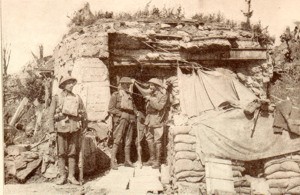
A Boche concrete gun pit used by its captors. Many of these strongholds were constructed so massively that the enemy could not destroy them even when they retired.
America's War for Humanity
"How hand grenades are thrown at the enemy in the trenches. American soldiers soon became expert at this superlative kind of baseball."
US Official photo
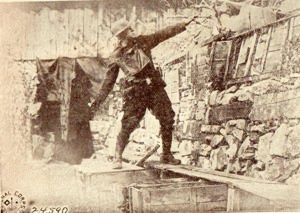
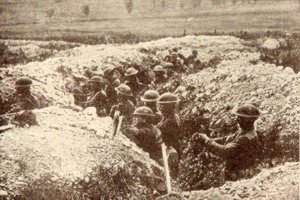
"Men of the 132nd US Infantry, 33rd Division, in a front line trench looking toward the valley of the Meuse, where it is estimated 70,000 men lie buried."
US Official photo
Clinton Meister, Infantry, AEF, Ripley County, Indiana
“Drove to the front at night with food and ammunition. Were shelled by enemy almost every trip. Out of 156 men in the company, however, lost only two, one gassed, one with influenza. During the day was located five or six miles from the firing lines aimed to keep out of range of shells. Airplane located them from time to time and signaled the artillery. Drove through field detours as all roads were constantly shelled and dangerous. Also badly torn up by the shelling, holes depending in size, upon the size of shells used by the enemy. In one retreat the Germans left two horses and a mule in a stable at Brancourt which were taken over by the Americans.”
Floyd Dillon Holmes, Co, D, 125th Inf., KIA, Grant County, Indiana
Corporal Holmes’ body was buried by his comrades on the battlefield and near the spot he was killed. Several months later it was removed to the American Cemetery at Seringes-et-Nesle, Aisne, near Fere-en-Tardenois, France. His grave is #144, Plot #3, Section R.
The commanding officer, Co. D., 125th Infantry, in a letter to a relative of Corporal Holmes, stated that he died in the Field of Honor and while engaging in the performance of his military duties, also the commanding officer and the members of this company, extend you and the members of Corporal Holmes family, their deepest sympathy and constantly bear in mind the remembrance of one of their most loved and respected non-commissioned officers.
Later, relatives of Corporal Holmes also received a letter from General John J. Pershing, commander-in-chief of the American Expeditionary Forces, in which he expressed his sympathy and stated that “Corporal Holmes died bravely in the line of duty on the Field of honor.”
Amos George Wesler, Musician, Ripley County
“The 112th Infantry Band won a contest with three other infantry bands of the 28th Division in the first week of March 1919 and was sent to Monte Carlo for two weeks as compensation. Started from LeMans, April 3, 1919. Stopped at Tours on April 4. Lost the band instruments here through their having been put into a small boxcar and the musician’s car put on another train. Stopped at Lyon April 6, stopped at Marseilles, April 7. Reached Monte Carlo, April 8. Attended the performance of Tosca at the Casino at Monte Carlo. Started on April 8 on an automobile trip into Italy. On April 9 received a message to return to LeMans as the regiment had received sailing orders. Reached LeMans again on April 12th.
“On March 28, 29 and 30 an Athletic Military Band contest was held at LeMans. The 112th won this contest, a gold medal to be worn by the bandleader. Seven other divisions took part in this contest. The 35th and 77th were two of the contesting divisions.”
Murray Bennett Frazee, 1st Lt., Infantry, Tippecanoe County, Indiana
Entered service Aug. 27, 1917. Attended Officers’ Training School at Ft. Sheridan, Ill. Commissioned 2nd lieutenant Nov. 27. 1917. Sent to France. Unassigned. Jan. 3. 1918. Attended officers’ school at Langres and officers’ bayonet school at St. Pol. Attached to the British 55th Division along LaBasse Canal. Transferred to 30th Division, but operated with British under General Haig until after signing of the armistice. This division took over part of the line in Belgium in front of Ypres until September. 1918. Moved to St. Quentin area. And attacked and broke the Hindenberg line, capturing towns of Bellicourt and Nauroy. Was under almost constant fire from Sept. 26 to Oct. 20, 1918. Was moved to LeMans in November 1918. being for the first time with the American Army. In October. 19 18. promoted to 1st Lt., acting as Aid de Camp to General Tyson at 59 th Brigade Headquarters. Born at Frankfort, Ind., May 5, 1891, son of Thomas D. and Alethea C. Frazee. Wife is Caroline Mathews Frazee. Graduate of Frankfort high school and attended Purdue University. Home is Lafayette, Indiana.
William Edward Gilland, KIA, Ripley County, Indiana
“The 30th (Old Hickory) Division entered the trenches the latter part of June 1918. The division, with the British and commanded by Sir Douglas Haig. One half of the division was reported killed at Bellicourt September 29 - October 10, 1918. William Gilland was killed near Busigny, Nord France.
“His Grandfather Gilland enlisted at the outbreak of the Civil War and gave his life at Atlanta Georgia.”
William Blount Harsh, Infantry, Decatur County, Indiana
“After entering in the service I was put in the 84th Division, Co. A, 333rd Infantry, and was sent overseas with this division. After training about two months this 84th Division was busted up and used as replacements in the 85th Division about the first of October the 6th, 1918, and from that date on I was with the 85th Division, Co. E, 138th Infantry. Up to January 3rd, I took the mumps and was sent to the Base Hospital 91, Ward C, Commercy, France, and on my return my old Company was filled up and I was put in G Co., 138th Infantry, 35th Div.
Far as seeing any battles, I did not, but I was up in the front line trenches and done my part holding the lines. My first time in the trenches was October 14th, 1918 in the Verdun Sector. We were heading for a big drive at Metz when the Armistice was signed so we were turned back, and little by little, we got on our homeward journey.
Yours respectfully,
William Blount Harsh
James Blane Bicknell, Pvt., Supply Co., 152 nd Infantry, Hamilton County, Indiana
Goldstar “He was transferred to Co. H., 152 Infantry on November 9 to Camp Shelby. On May 6, 1918, was transferred to Supply Co., 152 Infantry, and a few days later was sent to the hospital in Camp Shelby for treatment.
Was transferred later to Co. 125th Infantry, 156th Regiment, and later was operated on for a tubercular kidney. Remained in the hospital at Camp Shelby up until the summer of 1919 then was removed to Fort Benjamin Harrison but only remain there five or six weeks. Then was sent to Fort Sheridan, Illinois, and was operated on there a second time.
He died July 10, 1920, while he was home on a furlough, still belonging to Co. H, 125th Infantry, 156th Regiment, Fort Sheridan, Illinois, Ward 49.
Christian Marlowe Herbig, KIA, Marion County, Indiana
Spent 30 days at Camp Taylor, 10 days at Camp Mills, New Jersey. Killed in service, August 9, 1918, “Somewhere in France”, presumably Château-Thierry Campaign.
Chris Marlowe Herbig, aged 24 years, was inducted into service, March 27, 1918, having previously been exempted on account of being the sole support of his mother, Mary Herbig, who died March 6, 1918, her demise placing him subject to draft call. He spent 30 days at Camp Zachary Taylor, Kentucky, and 10 days, at Camp Mills, New York, then en route to France. Arrived in France, early in May, being a Private in Co. E., 47th Infantry. Little is known of his whereabouts during this time, up to the notification of his death.
David Hannibal Hughes, AEF, Ripley County, Indiana
“David Hannibal Hughes’ grandfather served three years and eight months in the Civil War. He was David A. Tucker and volunteered at the age of seventeen.
“Incidents of David H. Hughes training and service: while at Camp Sherman camp out 3 weeks in artillery range at Stony Creek.
‘Sent on special training, Scout Duty, Intelligence Section, 3 weeks in Southern France.
“Marched to Germany, Nov. 14 - Dec. 1, 1918, crossed Alsace-Lorraine and Luxemburg en route.
“Stationed at various places near Coblenz, Germany with Headquarters divisional at Mentabor. Served about I month in a mounted troop at Mentabor, trained for patrol work. Served as a bodyguard for Gen. McLaughlin and Brig. General Parker. “Left Germany, Aug. 20, 1919, entrained for Brest. Returned via Belgium passing Urungle Cologne on the Rhine and Flanders Field.”
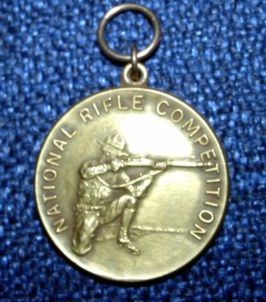
National Rifle Competition Medal
Indiana War Memorial Collections
"Wounded man making his way painfully back to the rear, with grim determination to keep going and all the grit of the typical American soldier."
US Signal Corps Photo, America's War for Humanities
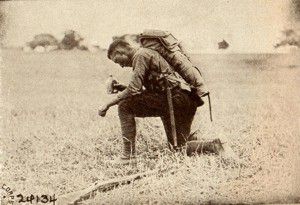
Testimonials:
More stories:
Sergeant Harry Lynn Kutchbacke, Marion County, Indiana
358th Infantry, 90th Div., April 28, 1918, attached to Co. H., 349th Infantry, 88th Div. Transferred to Camp Travis, San Antonio Texas, May 18, 1918, to Co. A, 358th Infantry, 90th Div., or Cocked Hat Division, so-called because of the distinctive raising of the head to salute. The only Div. to characterize on this, but it was special orders of Major General Allan.
His shooting on the rifle range at Camp Bullis, Texas, the week of May 27 to June 3, make a marksmanship record and entitling him admission to Sniper School. On June 8, one day previous to the departure of 90th Div. for overseas rejected on overseas examination and transferred to Co. 36, 9th Battalion, 165th Depot Brigade at Camp Travers, Texas. Here he was assigned to help drill the recruits and later with personnel of the Company. He assigned the recruits to various detail work.
During the flu epidemic, he assisted with the clerical work. Promoted to Corporal September 31, 1918, promoted to Sergeant October 10, 1918, discharged with excellent character by Captain Otto E. Penz, Co. 36, 9th Battalion, 165th Depot Brigade on December 5, 1918.
William A. Schneider, 30th Div., Ripley County, Indiana
“30th Division arrived in France May 24th, 1918; Canal Sector, South of Ypres (brigaded with British, July 16 to August 17, 1918. Canal Sector, South of Ypres (Under one command) August 17 to September 4, 1918. Gouy Nauroy Sector, September 23, to October 2, (battle operations), Le Chateau Sector, October 16, to 20th, (battle operations). Prisoners captured: 98 officers, 3,750 men. Guns captured: 81 pieces artillery, 426 machine guns. Total advance on front lines, 29 ½ kilometers.”
Donald F. Roberts, Infantry, Marion County, Indiana
Enlisted February 4, 1918, and Indianapolis, Indiana. Join the railroad service for Uncle Sam, left Camp grant, February 5, 1918, where we were assigned to the 13th Engineers, leaving March fourth for Camp Merit, New Jersey. Sale from Hoboken, March 13 on the good ship J. H. Malory a Banana boat, arrived at Bordeaux, France March 26.
The boys were wild with joy at the sight of land and as we sailed up the Geroude River, the vineyards on both sides made a beautiful scene. Trained a few weeks and entered service May 5 at Fleury-sir-air and on June 7 we were sent on a supply train, to Clarmont in the Argonne forest, four miles from the trenches, where we served during the drive there. September 8 he was struck with shrapnel while serving as a cook in the absence of the regular cook, receiving a slight wound in the forehead. On January 24, 1919, he lost his right foot while in service, and from that time on was in the hospital till arriving home May 25 on the good hospital ship Mercy.
Bert Kindelsparkes, Co. A, 30th (Old Hickory) Div., AEF, Ripley County, Indiana
Burned by a gasoline explosion. Hospitalized in Beaumont, France: lower limbs burnt.
“This soldier’s memory seems to be affected so that his record is somewhat vague and uncertain. It doesn't seem that he could have been assigned to the 30th Division. He was surely assigned to the 84th Division.”
Robert E. Ostler, Corporal, Infantry, Tippecanoe County, Indiana
Entered service Sept. 22, 1917. Stationed at Camp Taylor, Ky., and Camp Shelby, Miss. Sailed for France in June, 1918. Saw active service. In his third battle, his right arm was hurt so badly that amputation was necessary. Was later returned to the United States, and sent to a hospital at Ft. Snelling, Minn. Born near Dayton, Ind., Sept. 21.1890, son of William Alonza and Sarah M. Ostler. Home is Lafayette, Ind.
John C Martin, Chief Mechanic, 335th Infantry, Vanderburg County
Letter home dated July 15, 1918, posted from Belgium, after serving on the Hindenburg line:
"Air raids are common occurrences. I have been in many of them, as scarcely a night passes but that we see battles in the air. Just now as I write there is real excitement outside. Some of the experiences I've been through have made the outcome for the time seemed doubtful. There are several boys here with me now, and they are making a remarkable showing for themselves.
After the event I went in a mopping up party, and we went through miles of an underground tunnel. I buried several little German boys, seemingly not more than 15 years of age, and we found several of them chained to machine guns. We found a crematory where the Germans cut up their own dead, and use the grease for their high explosives." It was a gruesome spectacle of which only the eye can get a fair conception. Source 41
Golden Grant Hull, AEF, Ripley County, Indiana
“Marched from Jametz, France, through Belgium and Luxemburg to Coblenz, Germany, reaching there on December 13, 1918. Left Easter Sunday, April 20, 1919.
“Transport Huron was formerly a German Ship. The Kaiser had made two trips around the world in it.”
George Knight McCain, Sgt., Co. L, 3rd Cavalry, Howard County, Indiana
Served 20 months in France, stationed at Burbonne Les Baines and Romorantum. Previous service on the Mexican border with Co. L, 2nd Indiana Infantry.
1st Battalion, 1st Div., 16th Infantry, arriving on the field with their colors. Peasants working nearby.
Photo courtesy of Indiana War Memorial
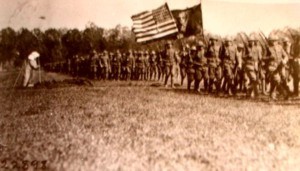
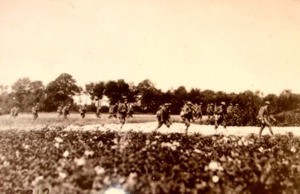
114th Infantry, 29th Division, advancing in combat formation in France.
Photo courtesy of Indiana War Memorial
134th Infantry Scouts Playing cards in a moment of leisure
Photo courtesy of Indiana War Memorial
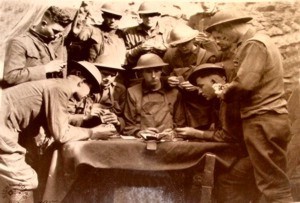
The 80th Division Headquarters in their French billets, Beauval, France.
National Archives photo, courtesy of IWM
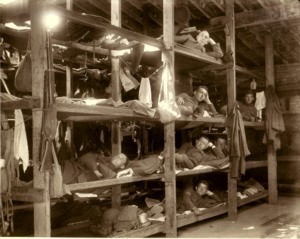
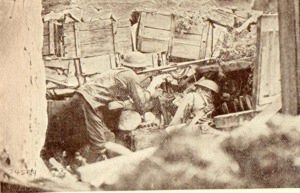
"American automatic rifle team making it hot for the Huns. Note protective barricade of ammunition boxes and sandbags."
America's War for Humanities
Infantry marching beside the trenches.
Source Unknown
